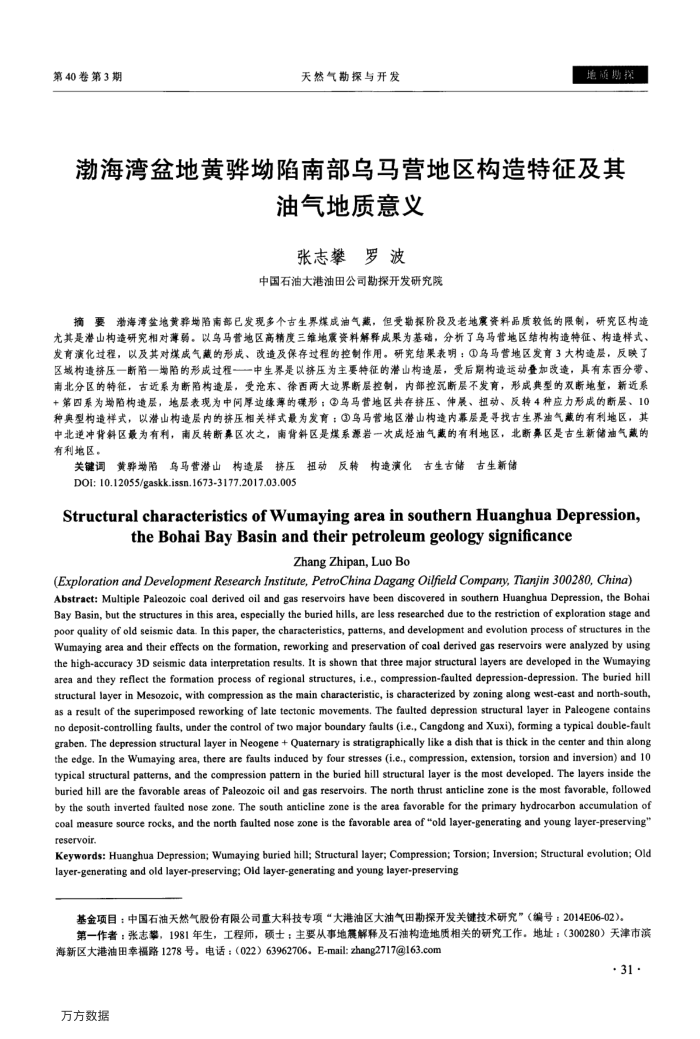渤海湾盆地黄骅坳陷南部乌马营地区构造特征及其油气地质意义
内容简介
 第40卷第3期
第40卷第3期天然气勘探与开发
地随勘探
渤海湾盆地黄骅坳陷南部乌马营地区构造特征及其
油气地质意义张志攀罗波
中国石油大港油田公司勘探开发研究院
摘要潮海湾盐地黄释地陷南部已发现多个古生界煤成油气,但受勒探阶段及老地震资料品质较低的限制,研究区构造尤其是潜山构造研究相对薄弱。以乌马营地区高精度三维地震资料解释成果为基础,分析了乌马营地区结构构造特征、构造样式、发育演化过程,以及其对煤成气藏的形成、改造及保存过程的控制作用。研究结果表明:①岛马营地区发育3大构造层,反映了区域构遗挤压一断陷一域陷的形成过程一中生界是以挤压为主要特征的潜山构造层,受后期构造运动叠加改造,具有东西分带、南北分区的特征,古近系为断陷构造层,受沧东、徐西两大边界断层控制,内部控沉断层不发育,形成典型的双断地堑,新近系 +第四系为端陷构造层,地层表现为中间厚边缘萍的碟形;①乌马管地区共存挤压、仲展、粗动、反转4种应力形成的断层、10 种典型构造样式,以潜山构造层内的挤压相关样式最为发育:①马营地区潜山构造内幕层是寻找古生界油气藏的有利地区,其中北逆冲背斜区最为有利,南反转断鼻区次之,南背斜区是煤系源岩一次成烃油气盏的有利地区,北断鼻区是古生新储油气藏的
有利地区。
自乌马营潜山构造层挤压
黄羿地陷
关键词
DOl:10.12055/gaskk.issn.1673-3177.2017.03.005
专构造演化古生古储古生新储反转
Structural characteristics of Wumaying area in southern Huanghua Depression,
Zhang Zhipan, LuoBo
(ExplorationandDevelopmentResearchInstitute,PetroChinaDagangOilfieldCompany,Tianjin300280,China) Abstract: Multiple Paleozoic coal derived oil and gas reservoirs have been discovered in southern Huanghua Depression, the Bohai Bay Basin, but the structures in this area, especially the buried hills, are less researched due to the restriction of exploration stage and poor quality of old seismic data. In this paper, the characteristics, patterns, and development and evolution process of structures in the Wumaying area and their effects on the formation, reworking and preservation of coal derived gas reservoirs were analyzed by using the high-accuracy 3D seismic data interpretation results. It is shown that three major structural layers are developed in the Wumaying area and they reflect the formation process of regional structures, i.e., compression-faulted depression-depression. The buried hill structural layer in Mesozoic, with compression as the main characteristic, is characterized by zoning along west-east and north-south, as a result of the superimposed reworking of late tectonic movements, The faulted depression structural layer in Paleogene contains no deposit-controlling faults, under the control of two major boundary faults (i.e., Cangdong and Xuxi), forming a typical double-fault graben, The depression structural layer in Neogene + Quaternary is stratigraphically like a dish that is thick in the center and thin along the edge. In the Wumaying area, there are faults induced by four stresses (i.e., compression, extension, torsion and inversion) and 10 typical structural patterns, and the compression pattern in the buried hill structural layer is the most developed. The layers inside the buried hill are the favorable areas of Paleozoic oil and gas reservoirs. The north thrust anticline zone is the most favorable, followed by the south inverted faulted nose zone, The south anticline zone is the area favorable for the primary hydrocarbon accumulation of coal measure source rocks, and the north faulted nose zone is the favorable area of *old layer-generating and young layer-preserving" reservoir.
Keywords: Huanghua Depression; Wumaying buried hill; Structural layer; Compression; Torsion; Inversion; Structural evolution; Old layer-generating and old layer-preserving; Oid layer-generating and young layer-preserving
基金项目;中国石油天然气股份有限公司重大科技专项“大港油区大油气田勘探开发关键技术研究”(编号:2014E06-02)。
第一作者:张志攀,1981年生,工程师,硕士:主要从事地震解释及石油构造地质相关的研究工作,地址:(300280)天津市滨海新区大港油田幸福路1278号,电话:(022)63962706。E-mail:zhang2717@163.com
· 31·
万方数据